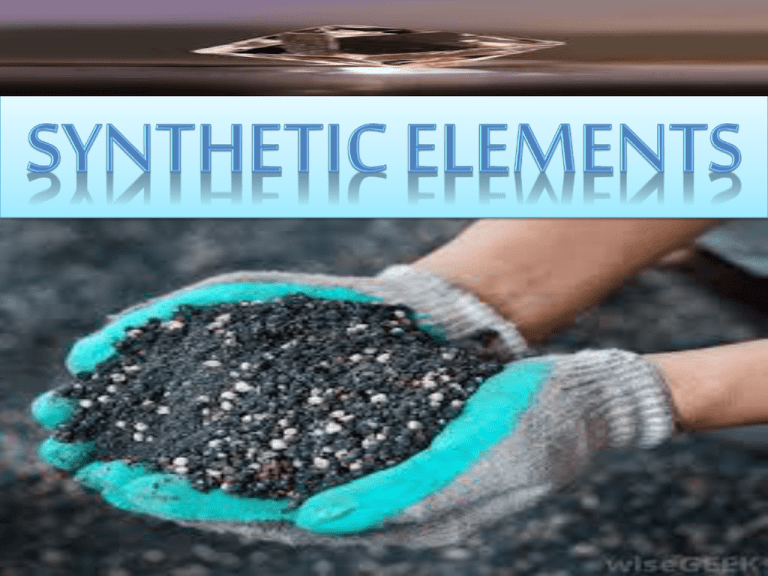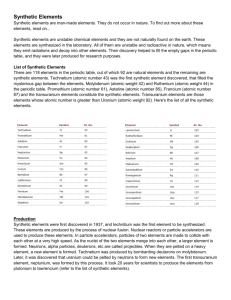periodic table - WordPress.com
advertisement

. Firstly I would like to tell you all about our periodic table The periodic table is a tabular arrangement of the chemical elements. The rows of the table are known as periods. The columns of the table are known as groups. The table is divided into different bocks known as s-block ,pblock ,d-block ,f-block. The table can be used to derive relationships between the properties of the elements and predict the properties of new, yet to be discovered or synthesized, elements. All elements from atomic numbers 1 (hydrogen) to 118 (ununoctium) have been discovered or reportedly synthesized. Periodic table is organized on the basis of their – • atomic number (number of protons in the nucleus). • electron configurations. • recurring chemical properties. SYNTHETIC ELEMENTS In chemistry, a synthetic element is a chemical element that does not occur naturally on Earth, and can only be created artificially. So far, 20 synthetic elements have been created (those with atomic numbers 99–118). All are unstable, decaying with halflives ranging from a year to a few milliseconds. Nine other elements were first created artificially and thus considered synthetic, but later discovered to exist naturally (in trace quantities) as well; among them plutonium—first synthesized in 1940—the one best known to laypeople, because of its use in atomic bomb sand nuclear reactors. Synthetic elements Synthetic elements are 1. Radioactive. 2. Decay rapidly into lighter elements. possessing half-lives so short, relative to the age of the Earth (which formed billions of years ago), that any atoms of these elements that may have existed when the Earth formed have long since decayed. 3. Atoms of synthetic elements only occur on Earth as the product of atomic bombs or experiments that involve nuclear reactors or particle accelerators. For synthetic elements, the isotope depends on the means of synthesis, so the concept of natural isotope abundance has no meaning. Therefore, for synthetic elements the total nucleus count (protons plus neutrons) of the most stable isotope, i.e. the isotope with the longest half-life—is listed in brackets as the atomic mass. Not all radioactive elements are synthetic. For instance, uranium and thorium have no stable isotopes but occur naturally in the Earth's crust and atmosphere. Unstable elements such as polonium, radium, and radon—which form through the decay of uranium and thorium—are also found in nature, despite their short half-lives. The first element discovered through synthesis was technetium. Only minute traces of technetium occur naturally in the Earth's crust—as a spontaneous fission product of uranium-238 or by neutron capture in molybdenum ores—but technetium is present naturally in red giant stars. No element with an atomic number greater than 98, (Californium), has been proven to have any use outside of scientific research. Synthetic elements with an atomic mass greater than 92 have been shown to have little or no use commercially, other than Plutonium, Neptunium, Americium, and Californium. Elements 99-118 are generally extremely short half-lived elements with no use other than research purposes. Element name Chemical Symbol Atomic Number First definite synthesis Bohrium Bh 107 1981 Copernicium Cn 112 1996 Darmstadtium Ds 110 1994 Dubnium Db 105 1968 (USSR), 1970 (USA) Einsteinium Es 99 1952 Fermium Fm 100 1952 Flerovium Fl 114 1999 Hassium Hs 108 1984 Lawrencium Lr 103 1961 Livermorium Lv 116 2000 Meitnerium Mt 109 1982 Mendelevium Md 101 1955 Nobelium No 102 1966 Roentgesium Rg 111 1994 Rutherfordium Rf 104 1966 (USSR), 1969 (USA) Seaborgium Sg 106 1974 Ununoctium Uuo 118 2002 Ununpentium Uup 115 2003 Ununseptium Uus 117 2010 Ununtrium Uut 113 2003 Element name Chemical Symbol Atomic Number First definite discovery Technetium Tc 43 1936 Promethium Pm 61 1945 Astatine At 85 1940 Francium Fr 87 1939 Neptunium Np 93 1940 Plutonium Pu 94 1940 Americium Am 95 1944 Curium Cm 96 1944 Berkelium Bk 97 1949 Californium Cf 98 1950 For further details about synthetic elements kindly visit to my next presentation





